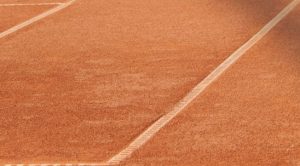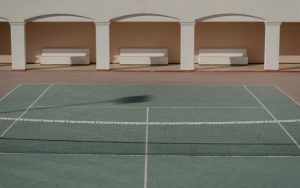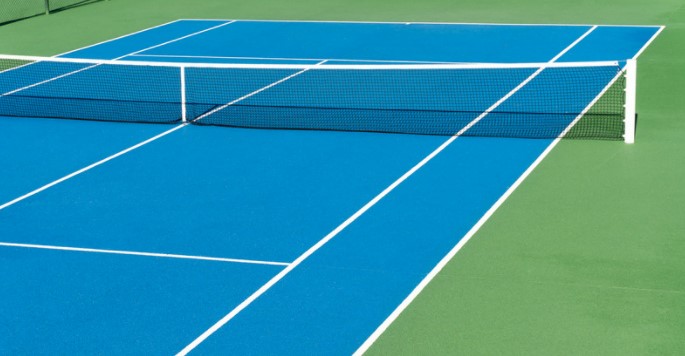Table of Contents
If you’ve been considering creating your very own tennis court on your property while also searching for ways to cut costs down, then taking on this project yourself could be a great option for you. If you have access to the right tools and consider yourself to be good at seeing a project through to the finish line, no matter the size of the undertaking, then this could very well be the best choice.
As with all large-scale design and construction projects, though, there are many steps to follow, and failing to do so could lead to some catastrophic and costly errors. To help keep you on the right track, we’ve put together the ultimate DIY tennis court guide, which you can use to put together a strong plan for your new project.
The Ultimate DIY Tennis Court Guide
Deciding On A location
One of the first things you need to take into consideration is the size of your tennis court. While this may seem obvious, tennis courts are big. So, deciding on exactly where to put it may be a challenge for many households. A tennis court will need an area of 120 by 60 feet, which gives you the space for the play area itself as well as the surrounding area. Without an adequate surrounding area, you won’t be able to run off the court or serve comfortably either.

Ensure you have a space on your property that could fit a court of these dimensions and make sure it’s accessible and won’t block any important property development. While not essential to consider, think about whether your court will block any views or impact the aesthetics of your property in any way, as this could impact the value of your property as well as your own enjoyment of your home too.
Drawing Up Your Plans
No project like this should be attempted without sufficient planning being done beforehand. If you’re doing this alone, you’ll want to ensure you’ve done all of your measurements accurately and have put plenty of thought and consideration into your new tennis court. These plans should include everything from materials and dimensions to extra equipment and your budget.
Don’t forget, with any home renovation project, that it’s wise to overestimate your budget to ensure you have some leeway for errors and unexpected costs. Set out each step of the project in your plan so that you can follow this to the letter and avoid making any significant mistakes.
Excavating The Area
The first step for starting the construction of your tennis court is to excavate the layer of soil, which will then be filled by your sub-base layer. This layer is usually around 1 foot deep, and while that doesn’t seem like much, digging all of that first layer alone with manual tools is going to be physically taxing, yet not impossible. To speed up the process, it may be worth hiring an excavation vehicle to make the job much faster and easier.

Once you’ve taken up that layer, it’s time to move on to laying the sub-base. This is where you’re going to fill in the area with backfill and load-bearing materials to strengthen your court. You’ll also want to add a layer for added drainage if your court is going to have a grass surface and be exposed to the elements. This stage can be quite complex, so it may be worth hiring an executive who is an expert in this work. They help you if you’re not fully confident in handling this part.
Installing Your Borders
Once your sub-base is complete, you’ll then want to install a tennis court surround system or pitch dividers like those available from sports supply stores like Edwards Sports Products. Whether you choose to have a rigid, tough border to your tennis court or a more affordable netting surrounding the area, it’s important to have some form of barrier for safety and to prevent the loss of tennis balls.
A rogue tennis ball could cause problems for neighbours or passers-by, especially if they’re driving and your court is near the road. Lost tennis balls can also cause local environmental damage due to their long decomposition time. A quality border around your court will help to limit lost balls finding their way into the undergrowth of the surrounding landscape, so consider this carefully.
Laying The Surface
When deciding on which surface to play on, there are a number of things to consider first. Of course, different materials are going to have a different impact on your budget, with a hard-court, acrylic surface being your best choice for affordability, and a high-quality clay surface nearly doubling the price. However, the surface has a huge impact on the style and pace of play and should be given significant thought.
If you’re looking for a good all-around choice for your tennis matches, then an acrylic surface is actually going to be the best choice. But if you’re searching for the traditional, powerful games of fast serves and volleys, a grass court will be the choice for you. On the other hand, the more expensive clay courts, or even an artificial clay court, provide you with a slower-paced yet more tactical playstyle, with the clay slowing the ball down slightly as it lands and allowing for a much higher bounce than other surfaces, especially turf.
Adding Extras
There are a few other things to consider when building your court. Although not entirely necessary, a storage shed could be great for your court area, especially if it’s outdoors. The cold, wet winter months can do some serious damage to your nets and posts if left out. Building a nearby storage shed or pavilion to pack away your equipment, including your rackets and other essentials, is a sound decision and will make life a little easier.

Having easy access to storage for your tennis court will provide you and your guests with somewhere sheltered to keep their possessions when playing too. A practice wall is another great addition to a court area, as sometimes you can get that itch to practice your moves but lack a partner to train with. When a game is specifically for two or more players, it can be quite restrictive when having to search for a partner every time.


